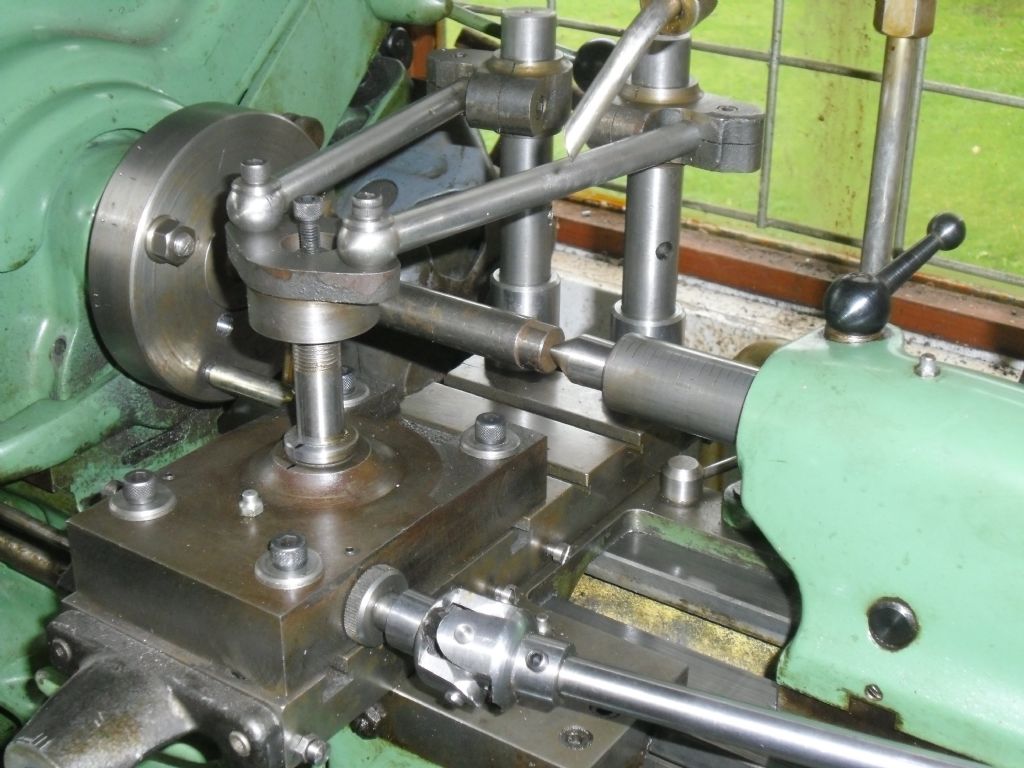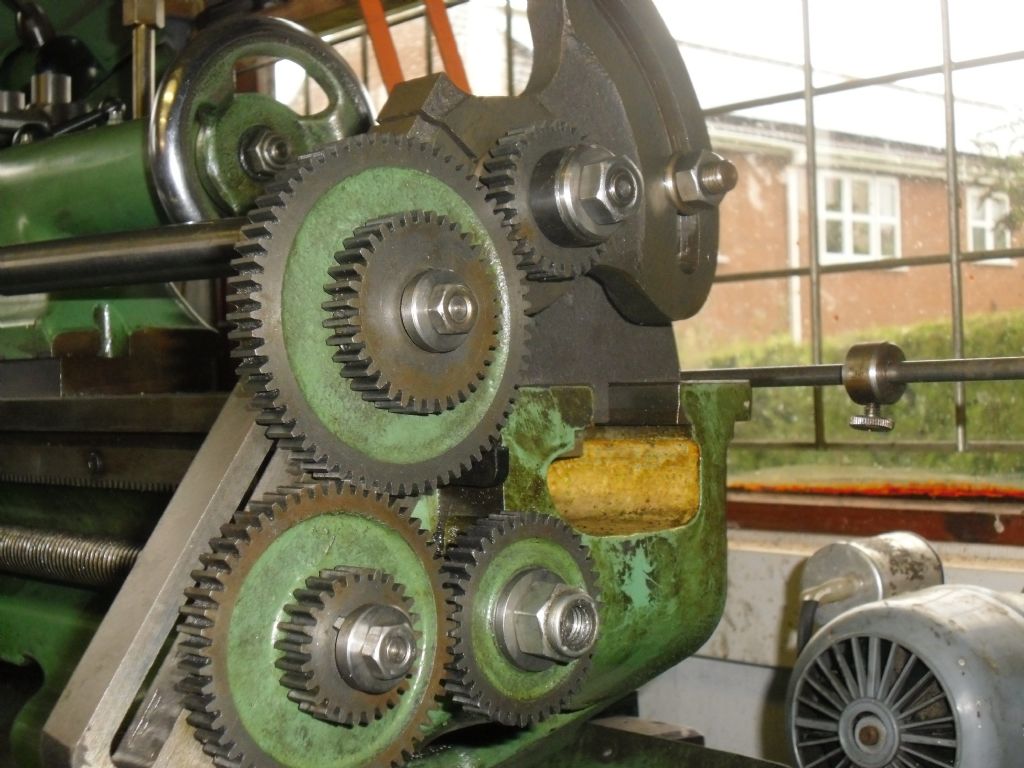Radford Worm-Wheel Hobber
| Chris Crew | 11/09/2023 21:40:37 |
418 forum posts 15 photos | I have built the Radford worm-wheel hobbing attachment as described in the book 'Improvements and Accessories for your Lathe' but not yet used or tested it. For those not familiar with the device it utilises the Myford leadscrew to transmit power to a train of change-wheels mounted on a banjo-arm at the tailstock end of the lathe with rotation from this gear-train taken to a vertical spindle set in a casting on the cross-slide on which the gear blank is mounted. This spindle is driven by a two-start worm meshed with a 32T worm-wheel inside the casting. In tandem with this device I am making the Radford Thread Milling Attachment as described in the same book and I am now at the stage where I need to hob the 20DP 15T worm-wheel which is integral to the milling spindle of the device. Radford shows that this is done with his worm-wheel hobbing attachment, obviously. In his hobbing attachment design and construction notes Radford states, "In designing this fixture, I decided to use the screw-cutting change wheels to determine the number of teeth and the tumbler gears to determine whether right or left-hand, and I decided that the number of teeth would be twice that set for screw-cutting. Any gaps in the range could be corrected by using a second set of change wheels driven by the tail-stock end of the lead-screw and driving a splined and universal jointed shaft back to the worm drive in the fixture........... This second set of change wheels is used in the following manner. Say 30 teeth are required. In the Myford gear-box there is no provision for 15, 30 or 60 teeth, so we set for 20 teeth in the gearbox which with one to one gearing would give us 40 teeth on the worm gear blank. We have to speed up the blank to cut 30 teeth in the ration 40:30 so we can fit a 40T wheel on the end of the leadscrew and a 30T on the spline shaft drive (or 60-45) so that a gear wheel of the same number of teeth as the change-gears are set for (x2) on the leadscrew end, and change gear of the required number of teeth on the blank will give us the correct gear ratio." I thought I sort of understood that, in principle at least, and I am assuming the (x2) Radford states accounts for the two-start worm drive in the fixture because he gives the option of using a single-start worm in the drawings but I thought I would try to be clever and prove to myself that I could cut a two-start worm. (I had the worm wheel cut by a local gear company because I was then in a 'chicken and egg' situation). My lathe does not have a gearbox, but that shouldn't matter, although now I have come to actually do the job it seems a little more complicated than I first thought because I am not very good at working out gear ratios. I am thinking that with the hob cutter set between centres in the lathe, which I am imagining to be a worm, then for every fifteen revolutions of this 'worm' the worm wheel (i.e. the gear blank) must rotate once. Am I correct in this assumption? Please tell me if I am wrong. What is really taxing my mental resources is the taking into account of the two-start worm to 32T wheel reduction in the fixture which seems a little at odds with the 15T worm wheel I need to cut. So, I suppose the real question is this: Can any of those people who seem to have this sort of thing calculated on spread sheets suggest a suitable train of gears that would resolve my dilemma, please? Edited By Chris Crew on 11/09/2023 21:42:07 |
| Chris Crew | 12/09/2023 15:12:24 |
418 forum posts 15 photos | Here are some photo's of the temporary set-up of the Radford Worm Wheel Hobber. I set the attachment up temporarily on the lathe and used the gears given Radford's example to cut a 30T worm-wheel. You have to imagine that the hob is mounted on the arbor between the centres and the gear blank is mounted on the vertical spindle. The catch plate shown is my interpretation of Radford's indexing catchplate, which he mentioned but never described, which in theory enables anything up to six-start threads and worms to be cut but in in reality three is probably the maximum achievable. I used it to cut the two-start worm and it worked a treat. The gear set-up appeared to work but I could not immediately explain why. The leadscrew was set to cut 20TPI, but it plays no part in the hobbing process except transmitting rotation to the banjo at the tailstock end of the lathe. There is a 40T gear on the end of the leadscrew and a 30T gear on end of the drive shaft. All the other gears are idlers. Subsequently, a forum member kindly PM'd me with some very helpful information. At this point in time I haven't completely got my head around it but I hope the penny will drop soon! Edited By Chris Crew on 12/09/2023 15:14:47 Edited By Chris Crew on 12/09/2023 15:26:58 |
| Frances IoM | 12/09/2023 17:03:31 |
| 1395 forum posts 30 photos | If you are a member of SMEE there were 2 online ie Zoom meetings this year of the Engine Builders Grp (both recorded) that dealt with the theory + building of the Jacobs gear hobber that was I think the basis of the adapt-a-Myford approach - membership is generally open and these recordings should be now available for members |
| Pete Rimmer | 12/09/2023 17:13:07 |
| 1486 forum posts 105 photos | I'm struggling to figure out what exactly the query is but if you are asking about the difference between using a single-start worm and wheel and a 2-start worm and wheel of the same tooth count to turn the gear blank, the 2-start worm will drive the wheel twice as fast because of the doubled lead. Therefore, if your single- start worm setup would yield a hobbed gear of 32 teeth, the 2-start worm setup will yield a gear of 16 teeth. |
| Chris Crew | 12/09/2023 20:30:56 |
418 forum posts 15 photos | I'm struggling to figure out what exactly the query is ........... I apologise if I didn't explain my confusion very clearly but in any event it has been resolved by a forum member who contacted me via the messaging centre so I will respect his privacy. My confusion arose because I had got it into my head that the 32T worm wheel and two-start worm formed part of the gear ratios that determined the number of teeth being cut which they do but only to the extent of producing a 2:1 reduction. Although the 8TPI Myford leadscrew plays no part in the hobbing process, except to transmit rotation to the banjo at the tailstock, it is obviously taken into account when calculating the speed reduction when cutting a thread or the number of teeth on a worm wheel. The 2.5 times speed reduction required to cut a 20TPI thread, i.e. 1/20" axial travel of the screw-cutting tool per revolution of the lathe mandrel, would be converted by the Radford device to a 1/20 rotation of the gear blank if it were a 1:1 ratio. Because the worm gearing reduces this by 2:1 it produces 1/40 of revolution of the gear blank. The increase in speed of 40:30 that Radford used increases this to 1/30 of a revolution, therefore 30 teeth. The penny finally dropped for this bear of little brain! Edited By Chris Crew on 12/09/2023 20:58:43 |
Please login to post a reply.
Want the latest issue of Model Engineer or Model Engineers' Workshop? Use our magazine locator links to find your nearest stockist!
Sign up to our newsletter and get a free digital issue.
You can unsubscribe at anytime. View our privacy policy at www.mortons.co.uk/privacy
- *Oct 2023: FORUM MIGRATION TIMELINE*
05/10/2023 07:57:11 - Making ER11 collet chuck
05/10/2023 07:56:24 - What did you do today? 2023
05/10/2023 07:25:01 - Orrery
05/10/2023 06:00:41 - Wera hand-tools
05/10/2023 05:47:07 - New member
05/10/2023 04:40:11 - Problems with external pot on at1 vfd
05/10/2023 00:06:32 - Drain plug
04/10/2023 23:36:17 - digi phase converter for 10 machines.....
04/10/2023 23:13:48 - Winter Storage Of Locomotives
04/10/2023 21:02:11 - More Latest Posts...
- View All Topics
- Reeves** - Rebuilt Royal Scot by Martin Evans
by John Broughton
£300.00 - BRITANNIA 5" GAUGE James Perrier
by Jon Seabright 1
£2,500.00 - Drill Grinder - for restoration
by Nigel Graham 2
£0.00 - WARCO WM18 MILLING MACHINE
by Alex Chudley
£1,200.00 - MYFORD SUPER 7 LATHE
by Alex Chudley
£2,000.00 - More "For Sale" Ads...
- D1-3 backplate
by Michael Horley
Price Not Specified - fixed steady for a Colchester bantam mark1 800
by George Jervis
Price Not Specified - lbsc pansy
by JACK SIDEBOTHAM
Price Not Specified - Pratt Burnerd multifit chuck key.
by Tim Riome
Price Not Specified - BANDSAW BLADE WELDER
by HUGH
Price Not Specified - More "Wanted" Ads...
Do you want to contact the Model Engineer and Model Engineers' Workshop team?
You can contact us by phone, mail or email about the magazines including becoming a contributor, submitting reader's letters or making queries about articles. You can also get in touch about this website, advertising or other general issues.
Click THIS LINK for full contact details.
For subscription issues please see THIS LINK.
Model Engineer Magazine
- Percival Marshall
- M.E. History
- LittleLEC
- M.E. Clock
ME Workshop
- An Adcock
- & Shipley
- Horizontal
- Mill
Subscribe Now
- Great savings
- Delivered to your door
Pre-order your copy!
- Delivered to your doorstep!
- Free UK delivery!














 Register
Register Log-in
Log-in


